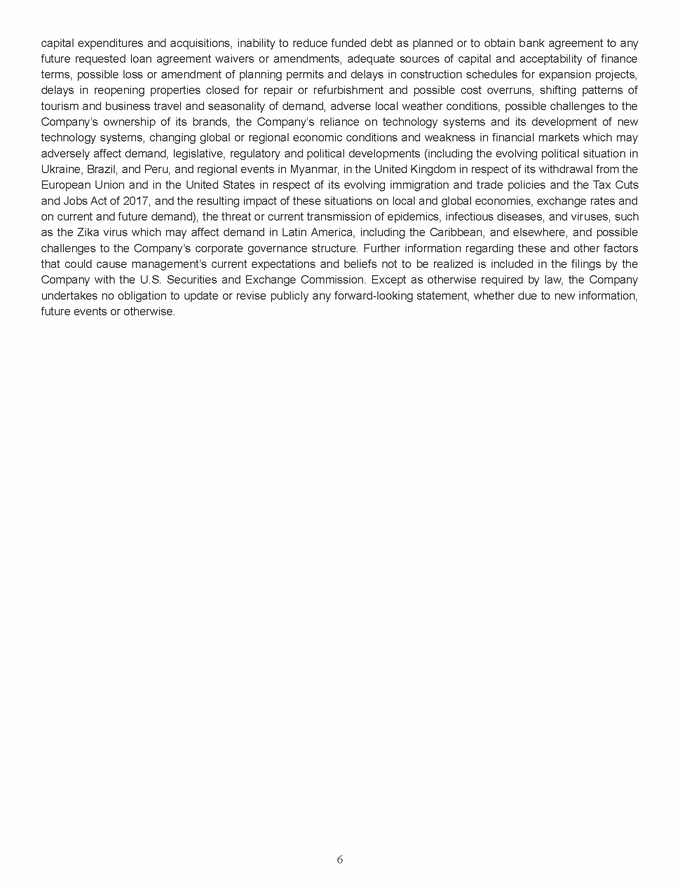Attached files
| file | filename |
|---|---|
| 8-K - 8-K - Belmond Ltd. | a18-11278_18k.htm |
Belmond Ltd. 2017 Annual Report President and Chief Executive Officer’s Message April 20, 2018 Dear Fellow Shareholders, The last twelve months were bittersweet for Belmond. As a Company, we made considerable progress on the execution of our strategic growth plan. But, concurrently, geopolitical developments and natural disasters in certain markets impeded our financial performance overall. The specifics of these global events, such as in the case of Brazil and the Caribbean, have been well-documented by the media and through our own financial updates each quarter. We have previously shared details of the swift action undertaken by our teams to mitigate the impact of these external factors on our own operations. But, it is fair to say that for Belmond, 2017 was a year defined by tough and testing external events. Nonetheless, I believe the cumulative force of the headwinds that Belmond faced have served to highlight the fundamental resilience of our business. Last year, we did more than simply withstand adverse operating environments; we demonstrated the underlying strength of our portfolio and the talent of our people. We maintained our financial discipline. We fulfilled the strategic investments to which we committed, and that will position the Company for future expansion. We pushed hard to capitalize on peak periods, driving average daily rates (“ADR”) and occupancy so that, despite the significant challenges in Brazil and also Myanmar, we still finished the year with a slight increase in revenue per available room (“RevPAR”). All the while, we worked closely with those businesses that were impacted by disruptive events. I am extremely proud of the team for pulling together under such challenging operating conditions. Throughout, our focus on executing our five-year plan has been unwavering and, consequently, we finished 2017 armed with the building blocks that we expect will support our anticipated accelerated growth in 2018 and beyond. I am disappointed that the financial results we recorded in 2017 do not reflect the great progress that we made as an organization. But, today, I am confident that our business is better positioned than it has ever been; that we have the tools and the talent to bring our financial performance back in line with the growth projections that we set out under our strategic plan, and which we achieved during our first year of execution in 2016. Moreover, I am confident that if we can realize our 2018 growth targets, we will have put our Company on the path towards delivering our ‘2020 strategic growth plan’ and, in turn, substantial long-term shareholder value. As we turn to the year ahead, we are seeing increasing momentum across our business. As all three of our strategic growth pillars evolve and advance, they form the foundation for the confidence with which we approach 2018. 2020 STRATEGIC GROWTH PLAN – DRIVING ORGANIC GROWTH To drive our organic growth, last year we retained our focus on those operating initiatives that would enhance our structure, resources, systems and product, building upon the solid foundations that were laid in 2016. The structure of our global operations has presented the clearest opportunity for continual improvement. Previously, we revised reporting lines across our sales functions. Having broken down silos, our commercial operation was able to build up its revenue-driving capabilities in 2017, and we expect to see the positive results reflected in our topline in the coming year. We also turned our attention to the re-organization of each Belmond business by market, creating five clearly defined divisions, with an appointed divisional leader to drive our performance in: Europe, Middle East & Africa; North and Central America, Caribbean; South America; Asia Pacific; and Trains & Cruises. We recognize that operational efficiency and accountability will be key if we are to meet our growth targets this year, and in the years that follow. To this end, each divisional lead now has clearly defined responsibilities that are tightly synchronized to our global business priorities, and these five solely report to Dan Ruff in the newly created role of senior vice president, head of operations. Dan joined the Company in January and is one of several major talents we have brought on board to ensure our Company has the appropriate resources to support our growth ambitions, and as we accelerate faster in the weeks and months ahead. In May 2017, we appointed a senior vice president to lead our sales, reservations and revenue management teams. Less than one year on and we have a greatly enhanced performance dashboard, providing frequent and far improved
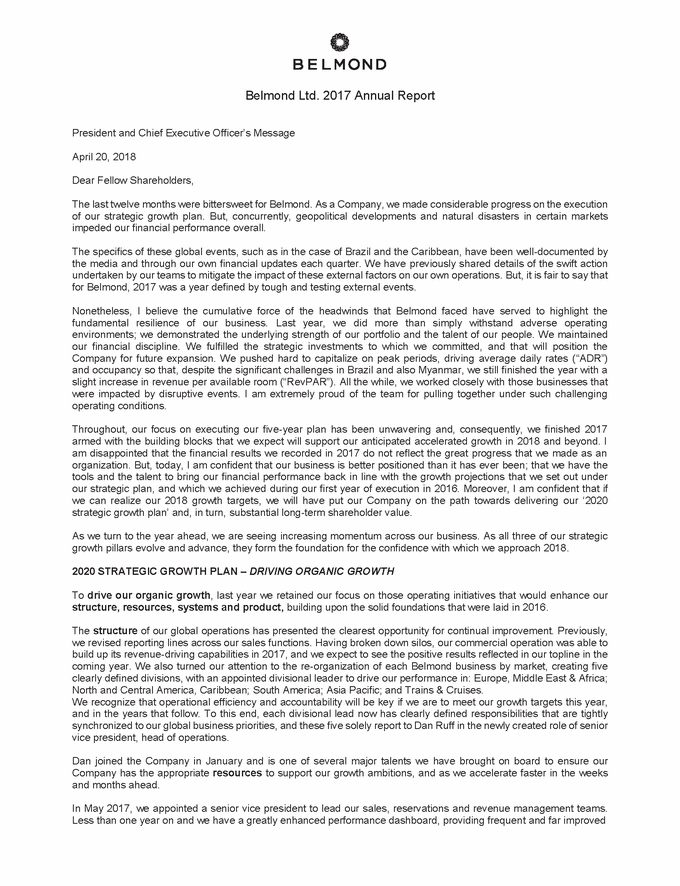
insight into our pacing against budget broken down by individual property, by sales period and by individual sales-person. We can identify areas of risk and opportunity further in advance and we have streamlined our teams so they can be deployed more effectively in response. We have a more dynamic pricing strategy in place and a firmer focus on driving occupancy, group sales and ADR. Looking ahead in 2018, we are seeing the early signs that these initiatives are having a positive effect on our topline performance. As our revenues rise, so too does our confidence in our ability to hit our growth targets this year. Elsewhere, we continued to invest in the systems to support our people in the delivery of our plan and help improve the end-to-end experience for our guests. The launch of a new, cloud-hosted website in September has brought the Belmond brand to life online and equips our business with the technology to compete in an increasingly digital world. Consistent branding and rich online content has been combined with a booking system that is more intuitive, straightforward and will allow our customers to add and update their personalized preferences at different stages of the booking process. Attention to such individual details are the backbone of our service offering on-property. In fact, we implemented a global ‘service culture’ training program this year to encourage consistency, without conformity, in our pursuit of operational excellence. In mirroring this standard of experience online, we hope to secure an increasing proportion of our total revenues through this commission-free channel. Our sales-force has been connected to a centralized Customer Relationship Management system, giving a single view of our customer and a growing database of information. As we move through 2018, we expect the roll-out of our new Business Intelligence system will allow us to further tailor our sales tactics and services to suit individual guest preferences and drive repeat custom across our products. At the same time, we have continued to re-invest in our portfolio, employing a disciplined approach to allocate capital to enhance our distinctive assets. We have an increasing number of case studies that demonstrate how these strategic investments are driving incrementally higher returns at our key products. From the updates made to the iconic Krysha ballroom at our Grand Hotel Europe, to the balconies added to rooms at Belmond Hotel Splendido. In 2018, the launch of grand ensuite cabins on board the Venice Simplon-Orient-Express and the reopening of the renovated Belmond Savute Elephant Lodge are among those products powering the performance of our existing business. In his role as Chief Operating Officer, Philippe Cassis has been instrumental in guiding our Company as we transitioned from a matrix of individual and disconnected product teams, to the streamlined and coherent collective that today has access to a first-class suite of tools, industry-leading talent and a single, shared ambition: to deliver Belmond’s financial goals. On this front, Philippe’s brief has always been to ensure that our business is set up for success. Having completed the re-organization, and with Dan now in place to drive our operational performance, Philippe will handover fully at the end of June 2018, in accordance with the announcement made earlier this year. I want to extend my personal thanks to Philippe for all that he has achieved in the course of his near three years. 2020 STRATEGIC GROWTH PLAN – BUILDING BRAND AWARENESS At the same time, brand momentum has been building. Increasing awareness of the Belmond brand was the primary objective of our brand and marketing team in 2017. Our global brand campaign, ‘The Art of Belmond’, is the story that threads through our long history and unites our individual properties together. It is the story of what defines us, and what sets us apart. The campaign creatives launched across print, social and digital channels in October and since then have been driving our message at scale. Last year, we increased our social following on all digital channels four-fold, and global media coverage of our brand reached an audience of 35 million worldwide. In the months that followed the campaign launch, two of our iconic rail products were featured in successive Hollywood blockbuster movies: ‘Murder on the Orient Express’ and ‘Paddington 2.’ We fostered exciting new brand partnerships with Leica Sport Optic and the London Philharmonic Orchestra. Each has enabled the expansion of our guest experience programs at select properties, further cementing Belmond’s position as the brand that creates authentic escape. In 2018, as we turn the full focus of our brand and marketing teams to increasing online revenues, we have given ourselves a strong foundation on which to build. In the first full quarter since our new website went live, there were over 2.7 million unique visitors and our strategic marketing activity led to a rise in online revenues of around 30 percent versus the prior year quarter. 2
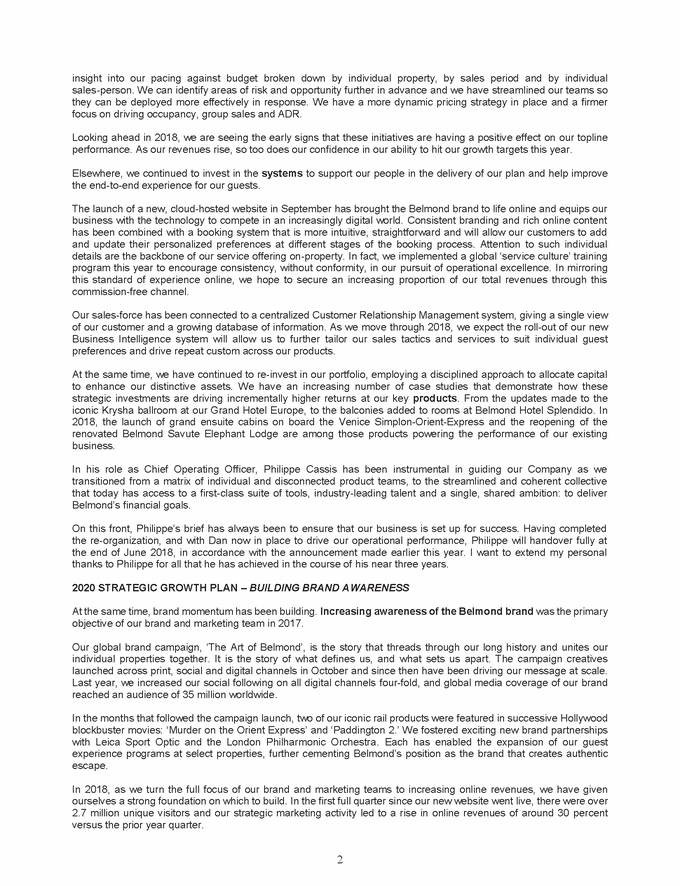
Today, backed by a new marketing strategy and a clearly defined brand, we have developed our digital ecosystem and invested in the digital marketing capabilities that will inform our ability to drive sales, recognize customers and reward loyalty. In supporting the performance of our existing portfolio, the brand must be recognized as an increasingly valuable tool. This is equally true as we pursue further footprint expansion. 2020 STRATEGIC GROWTH PLAN – EXPANDING OUR GLOBAL FOOTPRINT In terms of our development pipeline, 2017 was a year in which the essential building blocks were put in place and we have seen momentum gather. We started the year with the launch of South America’s first luxury sleeper train, an asset that is emblematic of Belmond’s unique luxury travel offering. We enhanced our Peruvian portfolio with the addition of Belmond Hotel Las Casitas, before succeeding in the complex and high-calibre acquisition of Belmond Cap Juluca. This property, as we know, was damaged in the wake of hurricane Irma last September. Following significant – albeit necessary – investment and extensive renovation, and as our marquee asset in the Caribbean, we can look forward to the property re-opening in time for the all-important peak season, in the fourth quarter of 2018. Still, overall, we did not close the total number of deals that we had targeted last year. It is fair to admit that it took us approximately one year longer than anticipated to develop the necessary processes and secure the required resources to jump start our development machine. We needed to find the right talent and we needed to build a brand that would help us to win in a competitive marketplace. We have started 2018 with all of these component parts in place, including, for the first time, a fully-staffed development team. The acquisition of the stunning Tuscan resort, Castello di Casole, followed in February this year, marking the fifth new product for our portfolio since the commencement of our plan. As a reminder, the adjusted EBITDA goal we targeted in 2016 was between $226 and $256 million by 2020, with roughly half of this amount coming from organic growth and half from footprint expansion. While we appreciate there is a lot of time and work to do before we reach the end of our five year plan, as of today we expect our existing business to outperform our organic growth target for 2020, and that this will offset the one-year lag in adjusted EBITDA contribution from the slower-than-expected execution of our development plan. Looking ahead, we are confident in our ability to ramp up our development activity. We have a development pipeline that is generating more quality opportunities than we, as a company, have seen before. Having already closed complicated deals in South America, Europe and the Caribbean and supported by our planned strategic capital recycling activity we are optimistic about delivering on our development goals in 2018. CONCLUSION Meeting the challenges of 2017 has helped us to define who we are today and inspired confidence in what we can become. In an increasingly competitive marketplace, Belmond has established an authentic and clear brand identity, built a team of inspired employees dedicated to serving our guests at the highest levels, and put in place a management team focused on driving robust financial performance. 2018 will be a pivotal year as we work to achieve the growth projections we set out under our strategic plan. I firmly believe that we have all the required building blocks in place to deliver on our RevPAR and other performance targets this year, and that this will put our ambitious 2020 goals well within our reach. We will maintain a consistent and focused approach to our strategic goals, internal values and our brand. We will build and extend our competitive advantages and capitalize on the many opportunities that lie ahead of us. We are armed today with a team that has never been more ready, more able or better equipped for the challenge. We start 2018 without complacency and with absolute conviction in our ability to deliver our plan and, thereby, long-term shareholder value. On behalf of the management team and my fellow directors, I would like to express my appreciation for your continued support. H. Roeland Vos President and Chief Executive Officer 3
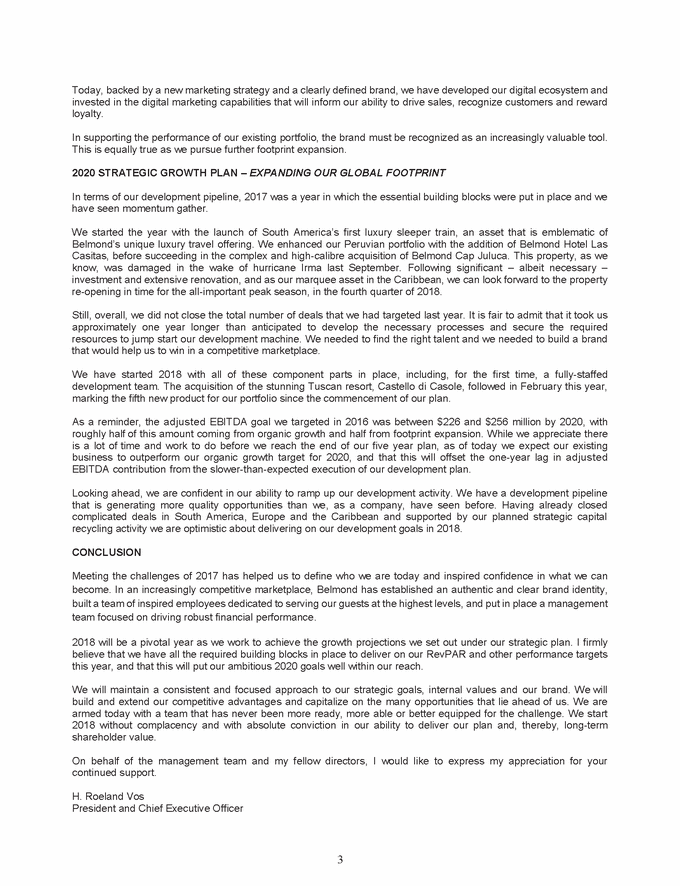
Use of Non-GAAP Financial Measures To supplement the Company's consolidated financial statements presented in accordance with U.S. generally accepted accounting principles ("U.S. GAAP"), which are filed with the Securities and Exchange Commission ("SEC") as part of the Company's annual report on Form 10-K and interim reports on Form 10-Q, management analyzes the operating performance of the Company on the basis of adjusted EBITDA. Adjusted EBITDA is the measure used by the Company’s management team to assess the operating performance of the Company’s businesses and, as disclosed in Note 24 to the financial statements and in Management’s Discussion and Analysis of the Company’s periodic report beginning with the Form 10-Q for the period ended March 31, 2017. Adjusted EBITDA is also presented on a consolidated basis because management believes it helps our investors evaluate the Company’s profitability on a basis consistent with that of its operating segments. Adjusted EBITDA is also a financial performance measure commonly used in the hotel and leisure industry, although the Company’s adjusted EBITDA may not be comparable in all instances to that disclosed by other companies. Adjusted EBITDA should not be considered as an alternative to earnings from operations or net earnings under U.S. GAAP for purposes of evaluating the Company's operating performance as presented in the Company's consolidated financial statements filed with the SEC. Adjusted EBITDA, when presented on a consolidated basis, including the items set forth in the Company's reconciliations tables, and adjusted net earnings / (losses) of the Company are non-GAAP financial measures and do not have any standardized meanings prescribed by U.S. GAAP. Adjusted EBITDA provides useful information to investors about the Company because it is not affected by non-operating factors such as leverage (affecting interest expense), tax positions (affecting income tax expense), the historical cost of assets (affecting depreciation expense) and the extent to which intangible assets are identifiable (affecting amortization expense). Adjusted EBITDA and adjusted net earnings / (losses) are unlikely to be comparable to similar measures presented by other companies, which may be calculated differently, and should not be considered as an alternative to net earnings or any other measure of performance prescribed by U.S. GAAP. Management considers adjusted EBITDA and adjusted net earnings / (losses) to be meaningful indicators of operations and uses them as measures to assess operating performance. Adjusted EBITDA and adjusted net earnings / (losses) are also used by investors, analysts and lenders as measures of financial performance because, as adjusted in the described manner, the measures provide a consistent basis on which the performance of the Company can be assessed from period to period. However, these measures are not intended to substitute for U.S. GAAP measures of Company performance as reflected in the Company's consolidated financial statements filed with the SEC. EBITDA, adjusted EBITDA and adjusted net earnings / (losses) have limitations as analytical tools. Some of these limitations are: they do not reflect the Company’s cash expenditures or future requirements for capital expenditure or contractual commitments; they do not reflect changes in, or cash requirements for, the Company’s working capital needs; they do not reflect interest expense, or the cash requirements necessary to service interest or principal payments, on the Company’s debt; although depreciation and amortization are non-cash charges, the assets being depreciated and amortized will often have to be replaced in the future, and EBITDA and adjusted EBITDA do not reflect any cash requirements for such replacements; and they are not adjusted for all non-cash income or expense items that are reflected in the Company’s statements of cash flows. Definitions All references to constant currency, which is a non-GAAP measure, represent a comparison between periods excluding the impact of foreign exchange movements. The Company calculates these amounts by translating prior-year results at current-year exchange rates. The Company analyzes certain key financial measures on a constant currency basis to better understand the underlying results and trends of the business without distortion from the effects of currency movements. Revenue per available room (“RevPAR”) is calculated by dividing room revenue by room nights available for the period. Same store RevPAR is a comparison of RevPAR based on the operations of the same units in each period, by 4
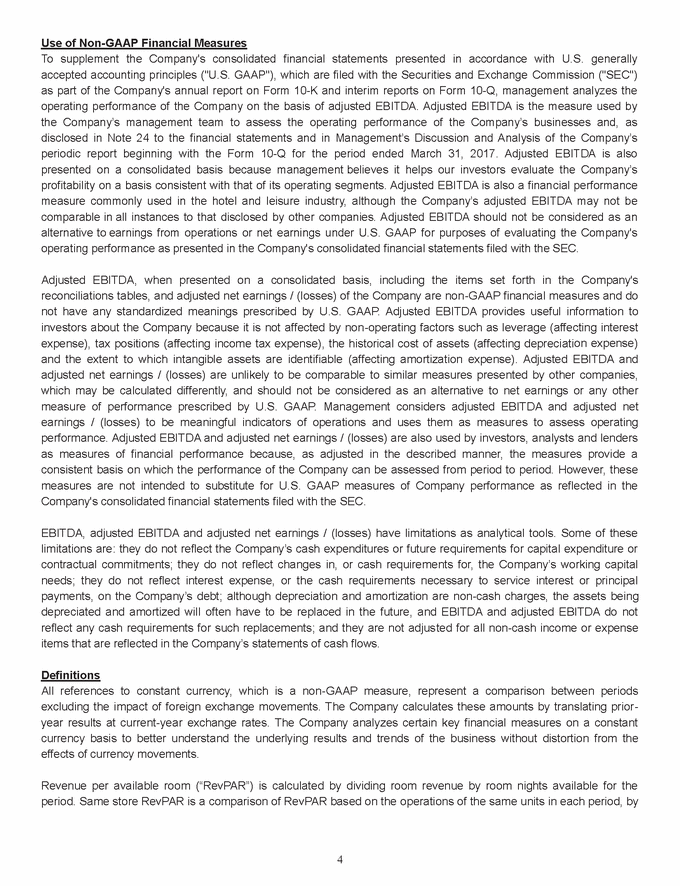
excluding the effect of any hotel acquisitions in the period or major refurbishment where a property is closed for a full quarter or longer. The comparison also excludes the effect of dispositions (including discontinued operations) or closures. Management uses RevPAR and same store RevPAR to identify trend information with respect to room revenue and to evaluate the performance of a specific hotel or group of hotels in a given period. Average daily rate ("ADR") is calculated by dividing room revenue by rooms sold for the period. Management uses ADR to measure the level of pricing achieved by a specific hotel or group of hotels in a given period. Occupancy is calculated by dividing total rooms sold by total rooms available for the period. Occupancy measures the utilization of a hotel’s available capacity. Management uses occupancy to measure demand at a specific hotel or group of hotels in a given period. Earnings before interest, taxes, depreciation and amortization ("EBITDA"), reflects earnings / (losses) from continuing operations excluding interest, foreign exchange (a non-cash item), tax (including tax on unconsolidated companies), depreciation and amortization. Adjusted EBITDA is calculated by adjusting EBITDA for items such as restructuring and other special items such as leases and sales, acquisition-related costs, disposals of assets and investments, impairments, and certain other items (some of which may be recurring) that management does not consider indicative of ongoing operations or that could otherwise have a material effect on the comparability of the Company's operations. Adjusted net earnings / (losses) is calculated by adjusting earnings / (losses) from continuing operations for items such as foreign exchange (a non-cash item), asset acquisitions, leases and sales, disposals of assets and investments, and certain other items (some of which may be recurring) that management does not consider indicative of ongoing operations or that could otherwise have a material effect on the comparability of the Company's operations. Net debt is the sum of the Company’s current portion of long-term debt and capital leases and long-term debt and obligations under capital leases minus the sum of the Company’s cash, cash equivalents and restricted cash. The Company measures long-term debt after deducting unamortized debt issuance costs and discount on secured term loans. Cautionary Statements This news release and related oral presentations by management contain, in addition to historical information, forward-looking statements within the meaning of the Private Securities Litigation Reform Act of 1995. These include statements regarding the Company's three-point growth strategy, future revenue, earnings, RevPAR, EBITDA and adjusted EBITDA, statement of operations and cash flow outlook, investment plans, debt refinancings, asset acquisitions, leases and sales, entry into third-party management contracts, operating synergies and revenue opportunities, operating systems, and benefits of the Company’s brand and similar matters that are not historical facts and therefore involve risks and uncertainties. These statements are based on management’s current expectations and beliefs regarding future developments, are not guarantees of performance and are subject to a number of uncertainties and risks that could cause actual results to differ materially from those described in the forward-looking statements. Factors that may cause actual results, performance and achievements to differ from those express or implied in the forward-looking statements include, but are not limited to, those mentioned in the news release and oral presentations, our ability to execute and achieve our three-point growth strategy, future effects, if any, on the travel and leisure markets of terrorist activity and any police or military response, varying customer demand and competitive considerations, failure to realize expected hotel bookings and reservations and planned real estate sales as actual revenue, inability to sustain price increases or to reduce costs, rising fuel costs adversely impacting customer travel and the Company’s operating costs, fluctuations in interest rates and currency values, uncertainty of negotiating and completing any future asset acquisitions, leases, sales and third-party management contracts, debt refinancings, 5
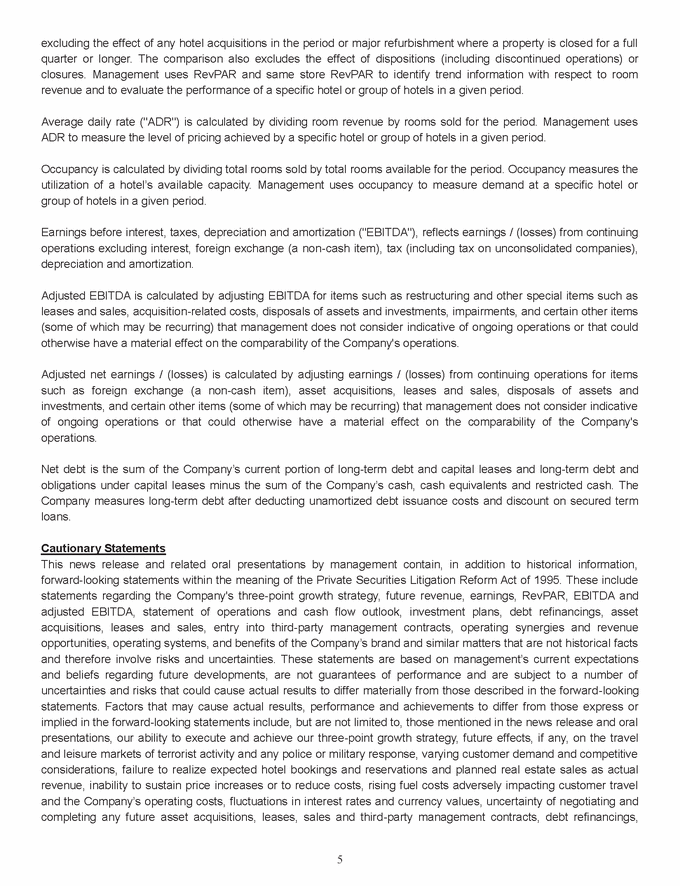
capital expenditures and acquisitions, inability to reduce funded debt as planned or to obtain bank agreement to any future requested loan agreement waivers or amendments, adequate sources of capital and acceptability of finance terms, possible loss or amendment of planning permits and delays in construction schedules for expansion projects, delays in reopening properties closed for repair or refurbishment and possible cost overruns, shifting patterns of tourism and business travel and seasonality of demand, adverse local weather conditions, possible challenges to the Company’s ownership of its brands, the Company’s reliance on technology systems and its development of new technology systems, changing global or regional economic conditions and weakness in financial markets which may adversely affect demand, legislative, regulatory and political developments (including the evolving political situation in Ukraine, Brazil, and Peru, and regional events in Myanmar, in the United Kingdom in respect of its withdrawal from the European Union and in the United States in respect of its evolving immigration and trade policies and the Tax Cuts and Jobs Act of 2017, and the resulting impact of these situations on local and global economies, exchange rates and on current and future demand), the threat or current transmission of epidemics, infectious diseases, and vir uses, such as the Zika virus which may affect demand in Latin America, including the Caribbean, and elsewhere, and possible challenges to the Company’s corporate governance structure. Further information regarding these and other factors that could cause management’s current expectations and beliefs not to be realized is included in the filings by the Company with the U.S. Securities and Exchange Commission. Except as otherwise required by law, the Company undertakes no obligation to update or revise publicly any forward-looking statement, whether due to new information, future events or otherwise. 6
